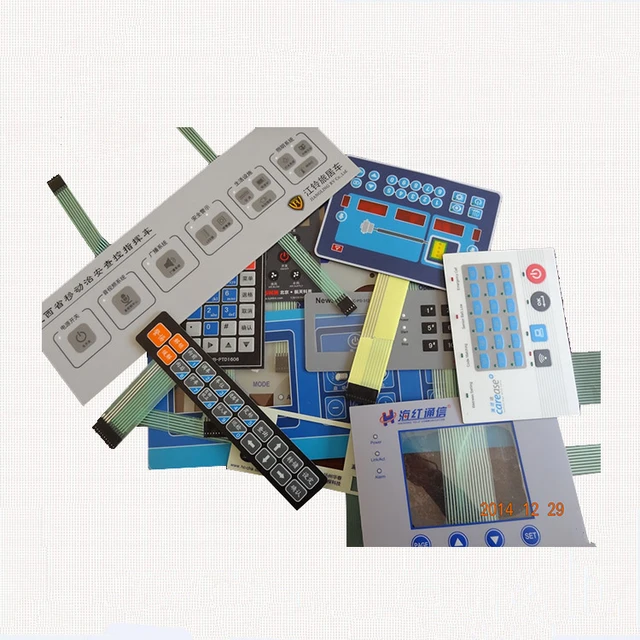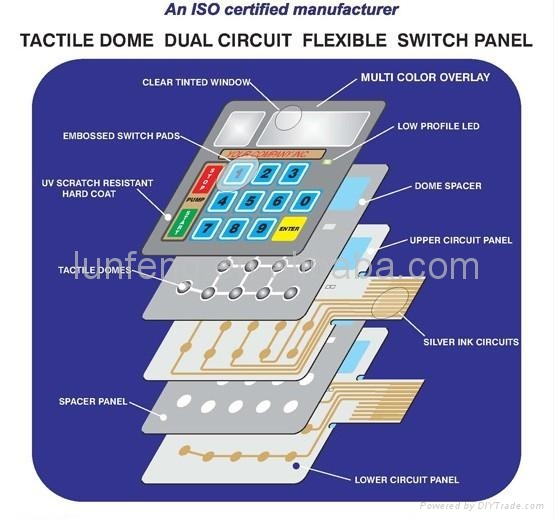Choosing the Right Membrane Switch for Your Business Needs
Choosing the Right Membrane Switch for Your Business Needs
Blog Article
Understanding Membrane Layer Switches: The Secret to Dependable and sturdy Controls

What Are Membrane Layer Buttons?
Membrane buttons are a sophisticated option in the realm of individual interface modern technology, incorporating functionality and style perfectly. These gadgets offer as a user interface between customers and digital systems, integrating a number of elements right into a portable layout. Generally built from flexible, slim layers of materials, membrane layer buttons are made to respond to touch, enabling users to interact with machinery and electronic devices effectively.
The primary elements of a membrane switch consist of a published circuit layer, visuals overlay, and a spacer layer that protects against unplanned activation. The visuals overlay can be customized to reflect brand name identity or customer choices, enhancing appearances while ensuring usability. Membrane switches are typically utilized in various applications, including clinical tools, customer electronic devices, and commercial tools, owing to their durability and resistance to environmental aspects such as dampness and dirt.
One of the essential advantages of membrane layer buttons is their capacity to stand up to deterioration, making them optimal for high-traffic atmospheres. Furthermore, they are light-weight and require minimal room, permitting ingenious designs in item advancement. In general, membrane switches over represent a practical and effective option for modern digital interfaces, weding innovation with user-centric layout concepts.
How Membrane Layer Changes Job
The procedure of membrane changes joints on a simple yet effective system that equates customer input into digital signals. When a user presses the switch, the top layer flaws, permitting a conductive element in the circuit layer to make contact with an equivalent conductive pad on the bottom of the graphic overlay.
The style of membrane layer buttons can vary, but they often integrate domes or responsive components to provide comments to the individual, improving the total experience - membrane switch. The products made use of in membrane layer switches, such as polyester or polycarbonate, add to their sturdiness and resistance to ecological variables, including moisture and dust. Additionally, the published circuits are normally encapsulated, which safeguards them from damage gradually.
Advantages of Membrane Switches

In addition, membrane buttons are known for their longevity. Constructed from robust materials, they are resistant to dust, wetness, and physical wear, which considerably extends their life expectancy contrasted to standard mechanical buttons. This longevity makes them specifically suitable for high-traffic atmospheres and try this applications needing durability.
Another significant benefit is the ease of cleaning and maintenance. The smooth surface area of membrane changes lessens dirt build-up and is commonly unsusceptible spills, making them excellent for setups that call for regular sanitization.
Additionally, membrane layer switches offer a streamlined account, bring about a thinner style that can be integrated into numerous tools without adding bulk. This feature not just improves the aesthetic appeal yet additionally adds to a much more ergonomic product design.
Applications of Membrane Buttons
Versatile and user-friendly, membrane layer buttons discover applications throughout a broad range of industries, consisting of clinical tools, consumer electronic devices, and industrial equipment. In the clinical field, these switches are integral to devices such as analysis devices, client websites monitoring systems, and mixture pumps, where dependability and convenience of cleaning are critical. Their capacity to keep and hold up against extreme environments capability makes them suitable for such applications.

In customer electronics, membrane buttons are used in items like microwaves, washing equipments, and remote controls - membrane switch. Their smooth layout enables instinctive interface, improving the total user experience while offering durability and resistance to tear and put on
Industrial equipment likewise profits from membrane switches, especially in control panels for equipment and automation systems. These buttons offer security versus dirt and moisture, making sure regular performance in difficult atmospheres. In addition, their click here to find out more customizable features enable suppliers to customize them to particular operational requirements, boosting efficiency and functionality.
Picking the Right Membrane Layer Switch
When selecting a membrane switch, it is vital to take into consideration numerous variables that affect efficiency and viability for details applications. The primary factors to consider consist of ecological conditions, responsive responses, sturdiness, and layout requirements.
First, assess the operating environment; switches subjected to wetness, chemicals, or extreme temperatures call for details products to make sure durability and capability. Next, evaluate the requirement for tactile comments. Depending on customer communication, some applications may take advantage of a responsive reaction to confirm activation, while others might favor a non-tactile style for aesthetic reasons.
Toughness is an additional crucial variable; membrane layer switches ought to be designed to hold up against regular usage, effects, and abrasion. Guarantee the picked switch can sustain the expected lifecycle, particularly in high-usage situations.

Final Thought
In verdict, membrane switches work as crucial elements in the design of trusted and sturdy control systems across various sectors. Their small design, incorporated with durable building and customizable attributes, improves user communication while making certain durability in demanding environments. The versatility of membrane layer changes enables customized services that fulfill certain functional requirements, enhancing their importance in modern-day technology. As sectors remain to progress, the importance of incorporating reliable membrane button solutions can not be overstated.
Membrane switches represent an important facet of modern interface style, blending performance with strength in numerous applications.Membrane layer switches are a sophisticated service in the realm of individual interface innovation, integrating capability and design perfectly. Normally built from adaptable, slim layers of products, membrane layer buttons are created to react to touch, allowing individuals to engage with equipment and electronic gadgets effectively.
The design of membrane layer switches can vary, but they often include domes or tactile aspects to give comments to the customer, boosting the total experience.In verdict, membrane layer changes serve as important components in the layout of sturdy and dependable control systems throughout different markets.
Report this page